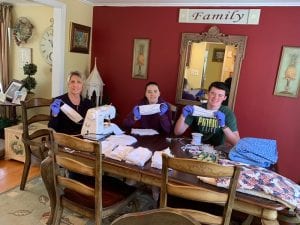As hospitals experience a significant lack of protective masks during the growing coronavirus pandemic, locals are looking for ways to assist, using on-hand materials and their own equipment.

Rebecca Kassay, who co-owns the Fox and Owl Inn in Port Jefferson, started a Facebook group, Suffolk County Creators of COVID19 Medical Supplies, to not only get the word out that there’s a need for homemade supplies but also to make sure locals are crafting these items the right way.
Kassay said there has been a growing demand for aid, and with so many people home from work and school, many are looking for ways they can help out.
“That’s what the group is aiming to do — to focus all of that information into one place,” she said.
Groups like Kassay’s have popped up all across the country as news of this lack of personal protective equipment grows. A national Facebook group called Open Source COVID19 Medical Supplies has put forward a countrywide initiative to crowdsource more of these protective items. This mainly includes gloves, gowns and masks.
The Suffolk group is just getting its legs but have already confirmed donations are accepted in several local places, including the Peconic Bay Medical Center in Riverhead, Pax Christi homeless shelter in Port Jeff, Welcome Friends Soup Kitchen in Port Jeff and Stony Brook University Hospital.
Kassay said the point of her group is to make sure people are making masks to a rigorous standard, following instructions provided by multiple sites including www.project-cloth-masks.com as well as documents provided by the OSCMS.
Angela Clayton, a historical costume designer from Manorville, said she started making masks because she had both the material and the skillset, and knew she needed to put them to use.
“I’m lucky to be financially stable and healthy, I wanted to help in any way I could,” she said.
The costume designer has been making masks from 100 percent cotton fabric, which can be used as a mask or as a cover for the more sought after N95 medical masks. She got her designs from www.makemasks2020.org, which not only gives designs but partners with groups around the country to get specifically requested designs from the makers to those who need them.
People all over Long Island have caught onto this trend. Old Field residents Bob and MaryLou Whitcomb, along with their neighbor Christine Matthews and her children Nicole and Connor, have been crafting handmade masks since Friday, March 20. MaryLou said the idea came after a phone call with her sister in Boston, with the person on the other end upset of her own close family members working in the health care field while severely lacking supplies of masks.
So far, the neighborhood team has made around 200 masks, which were mailed to Whitcomb’s sister. They have made masks for doctors in the Old Field area and also have plans to ship more to NYU Langone hospital.
“I thought to myself, we’re all sitting around — why don’t we do something?” MaryLou said.
There are some issues, including accessing supplies, particularly in terms of elastic, which has proved hard to come by. The Suffolk County Creators group has been trying to crowdsource materials from people who have it, especially the elastic bands. Though now there are more and more examples of people making ties from fabric instead.

Though area hospitals are loath to admit it, officials have said there is a general lack of PPE material in nearly every medical sector. Some of this is due to people hoarding such devices since the start of the outbreak. As cases ramp up, hospital workers have been dealing with the shortage. There are reported cases of hospital workers using masks meant for just a single encounter for over a week. Suffolk County Executive Steve Bellone (D) said there are some facilities, including nursing homes, first responders as well as hospitals, that have been reduced to a pittance of the preventative garb and devices.
Though Stony Brook University Hospital officials have said they “have supplies, but need more,” they have started accepting PPE donations.
“It’s amazing how people can come together to support one another in a time of crisis,” said Stony Brook University Hospital CEO Carol Gomes in an email statement. “We are grateful for the community’s willingness to help one another. We’re all in this together.”
A Stony Brook spokesperson said the hospital is “open to accepting all kinds of donations at this time. They will then be sorted and distributed appropriately.”
Despite this, Suffolk County Health Commissioner Dr. Gregson Pigott said in a phone call with reporters that masks need to be certified if they are to be of any use. Making masks at home is “not advised — we’re looking for masks that can help filter out the virus,” he said. “They need to be certified and tested.”
Kassay said she agrees these masks are not replacements for the professionally made and certified items normally used in the health care sector. At the same time, while other health care providers may have better access to the high filtering top-of-the-line N95 masks, people who work for food pantries, food banks or even just in retail do not have the same access to the high-grade PPE items. Not to mention, there are several designs for masks that can go over the N95 types, potentially allowing them to last longer without being soiled.
For those looking to get into making masks, Clayton said its best to order materials remotely and not threaten the spread of the virus. Use the resources available and try and contact groups that may need masks but are not in the medical field, such as shelters, clinics or senior centers to see what they may need as well.
Kassay said these homemade masks, at the very least, help remind people not to touch their nose or mouth, which experts have recommended people restrict themselves from doing.
“Something is better than nothing,” Kassay said. “We’re all living in this unprecedented time, we’re all wondering what we can do. You want to make sure you’re doing something in the best way possible.”
County Solicits PPE Supplies from Local Companies
In calls to reporters, Bellone said they simply do not have enough beds and other supplies for what still could be a ballooning of the number of coronavirus cases. Hospitals, officials warned, could be overwhelmed as we head toward a peak number of cases.
The county announced a donation drive for medical supplies. They are looking for donations of N95 masks, ear loop face masks, gowns and gloves from the construction industry, building trades and others in organized labor, as they are supplies that are often used on work sites. Additionally, the county is soliciting donations of ear loop masks and gloves from the personal service industry.
By the end of Monday, the first day of the drive, Bellone said they have already received “an incredible amount of outpouring and support.” This included 40,000 gloves of various sizes, 3,000 N95 masks, 1,500 gowns and over 3,000 ear loop masks.
Donations can be delivered to the Suffolk County Fire Academy located at 102 East Ave. in Yaphank between 10 a.m. and 2 p.m. on weekdays. Residents can email [email protected] regarding a large donation of supplies or a potential vendor of opportunity.
“You cannot continue to do these supplies on an ad hoc basis.”
— Andrew Cuomo
As of Monday, Long Island is set to receive 33,976 N95 masks, 86,170 surgical masks, 35,350 gloves, 14,512 gowns and 19,709 face shields. Cuomo admitted that even with these supplies, hospitals will need more especially in the long term.
Governor Andrew Cuomo (D) has said New York hospitals would need to increase the number of intensive care unit beds by approximately 18,000 to 37,000 in total to deal with the peak of the pandemic in New York. The governor put out an executive order saying hospitals must increase the number of beds by at least 50 percent.
Companies like 3M, which manufactures the N95 masks, would be shipping half a million masks to New York and Seattle.
But Cuomo said even such beneficial acts by a few companies belies the need for all such companies to step up to the plate. He has urged the Donald Trump (R) administration to invoke the Defense Production Act, which would allow them to order manufacturers to increase production of much-needed PPE items. The president has signed an executive order invoking the act but has yet to make a single order. Cuomo said those companies would be “paid handsomely” for the effort, but that it was needed more than ever.
“You can’t run this operation that way — it can’t just be based on ‘we’re waiting for people to come forward with offers,’” he said at the Monday press conference. “You cannot continue to do these supplies on an ad hoc basis.”







































